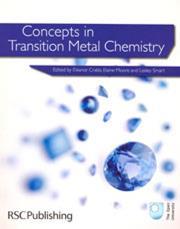Concepts in transition metal chemistry
Concepts in transition metal chemistry
Eleanor Crabb, E A Moore, Lesley Smart (Eds)
Cambridge, UK: RSC Publishing 2009 | 142pp | ?24.99 (SB)
ISBN 9781849730600
Reviewed by Peter Sadler

The material in this book will be very useful for chemistry undergraduates, especially in the first 2 years of their courses. It concentrates on the first transition series, and deals mostly with +2 and +3 oxidation states, although higher and lower oxidation states are briefly mentioned. A wide range of different types of ligands is described.
There is an emphasis on the thermodynamic stability of complexes including redox potentials and the concepts of hard and soft acids and bases. It is a pity that kinetics and reaction mechanisms are not dealt with.
Both crystal field and molecular orbital pictures of the transition metal complexes are presented and used to discuss their electronic absorption spectra and magnetic properties. All the absorption spectra have wavenumber scales, which usefully correlate with energy differences, but for starting undergraduates, some spectra with the reciprocal (nanometre) scale would have connected them more readily with their experimental spectra.
The text is especially well illustrated with clear, colourful diagrams, including pictures of minerals and solutions of metal complexes. There are interactive activities and video on the accompanying DVD, and bullet-pointed questions with answers in most of the sections.
Although much of the material in the book can be found in more comprehensive inorganic chemistry textbooks, the clarity of the material presented here will appeal to students in the early stages of their transition metal courses, and will be well consulted as a textbook in most libraries.












No comments yet